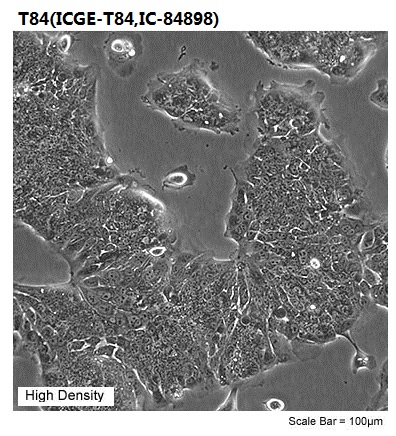


| Organism | Homo sapiens, human |
|---|---|
| Tissue | colon; derived from metastatic site: lung |
| Product Format | frozen |
| Morphology | epithelial |
| Culture Properties | adherent |
| Biosafety Level |
1
Biosafety classification is based on U.S. Public Health Service Guidelines, it is the responsibility of the customer to ensure that their facilities comply with biosafety regulations for their own country. |
| Disease | colorectal carcinoma |
| Age | 72 years |
| Gender | male |
| Applications |
The T84 cell line is a transplantable human carcinoma cell line. It is also a suitable transfection host.
|
| Storage Conditions | liquid nitrogen vapor phase |
| Karyotype | The stemline modal chromosome number is 56, occurring at 28% with polyploidy at 12.4%. Eighteen markers are common to most metaphases examined. Normal X and chromosome 13 were absent; chromosomes 2, 4 and 22 were single-copied, and chromosome 12 was 4-copied. No Y chromosome was detected by Q band observation. DM occurred in nearly 50% of the cells. |
|---|---|
|
|
|
| Derivation |
The T84 cell line is a transplantable human carcinoma cell line derived from a lung metastasis of a colon carcinoma in a 72-year-old male. Tumor tissue was inoculated subcutaneously and serially transplanted in BALB/c nude mice.
|
| Clinical Data |
male
|
| Receptor Expression |
neurotransmitter, expressed
peptide hormone, expressed
|
| Genes Expressed |
carcinoembryonic antigen (CEA), 600 ng/mL per 106 cells per 10 days; keratin
|
| Cellular Products |
carcinoembryonic antigen (CEA), 600 ng/ml per 10 exp6 cells per 10 days; keratin
|
| Tumorigenic | Yes |
| Effects |
Yes, in nude mice
(Tumors developed within 21 days at 100% frequency (5/5) in nude mice inoculated subcutaneously with 10(7) cells)
|
| Comments |
The original histological characteristics of the colon carcinoma were maintained throughout transplantation in nude mice. After 23 passages in athymic mice, the T84 cell line was established. These cells grow to confluence as monolayers and exhibit tight junctions and desmosomes between adjacent cells. They have receptors for many peptide hormones and neurotransmitters and maintain vectorial electrolyte transport. This line exhibits tight junctions, and desmosomes between adjacent cells. The cells are positive for keratin by immunoperoxidase staining. |
| Complete Growth Medium |
A 1:1 mixture of Ham''''''''''''''''''''''''''''''''s F12 medium and Dulbecco''''''''''''''''''''''''''''''''s modified Eagle''''''''''''''''''''''''''''''''s medium with 2.5 mM L-glutamine, 95%; fetal bovine serum, 5% |
|---|---|
| Subculturing |
Volumes are given for a 75 cm2 flask. Increase or decrease the amount of dissociation medium needed proportionally for culture vessels of other sizes. Corning® T-75 flasks (catalog #430641) are recommended for subculturing this product.
Subcultivation Ratio: A subcultivation ratio of 1:2 to 1:4 is recommended
Medium Renewal: Twice per week
|
| Cryopreservation |
Freeze medium: Complete growth medium supplemented with 5% (v/v) DMSO
Storage temperature: liquid nitrogen vapor phase
|
| Culture Conditions |
Atmosphere: air, 95%; carbon dioxide (CO2), 5%
Temperature: 37��C
Growth Conditions: The cells should be maintained at high density (at least 1/4 confluency).
|


